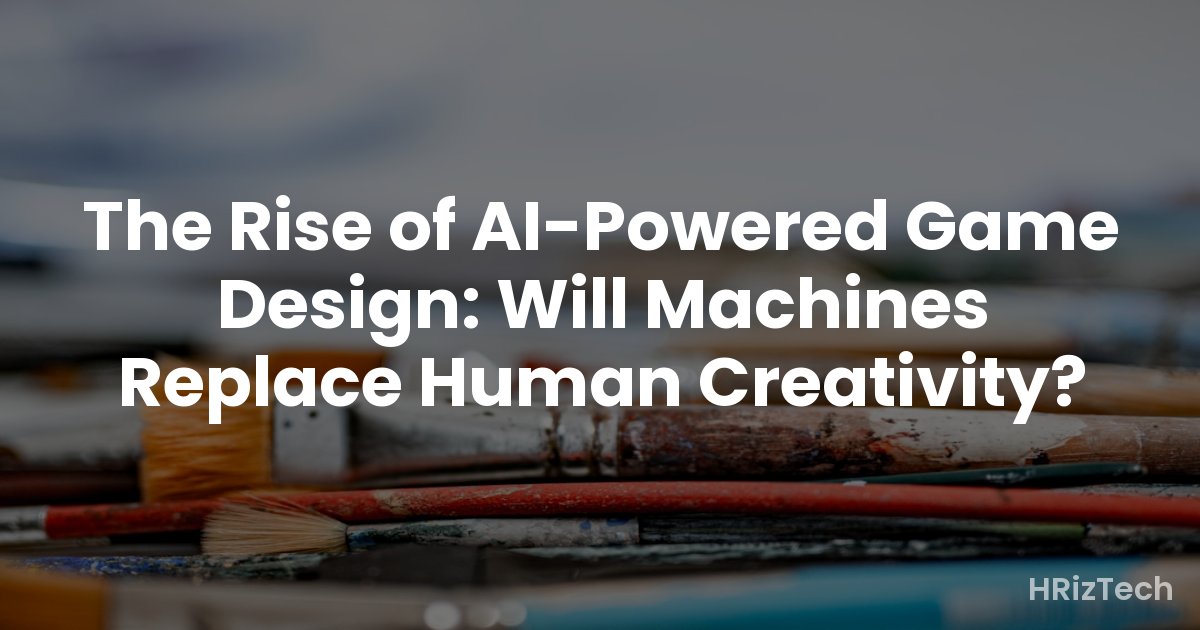The Rise of AI-Powered Game Design: Will Machines Replace Human Creativity?

The Rise of AI-Powered Game Design: Will Machines Replace Human Creativity?
Artificial intelligence is rapidly changing many aspects of our lives, and the gaming industry is no exception. From procedural generation to AI-driven characters, AI is making its mark on game design. But a crucial question looms: will AI replace the human element, the spark of creativity that makes games truly engaging?
- AI is enhancing, not replacing, human game designers.
- Procedural generation tools significantly speed up development.
- AI can personalize player experiences in unprecedented ways.
- The human touch remains vital for narrative, emotional depth, and unique game mechanics.
- The future likely involves a collaborative approach between humans and AI.
AI's Expanding Role in Game Development
Let's be clear: AI isn't about replacing human game designers overnight. Instead, it's about augmenting their capabilities. Think of AI as a powerful tool in the designer's arsenal, capable of handling repetitive tasks and generating vast amounts of content that would otherwise take human teams months, or even years, to accomplish. We're already seeing this in action with procedural generation, where AI algorithms create levels, environments, and even quests, drastically speeding up the development process.
Procedural Generation: Level Design on Steroids
Imagine creating hundreds of unique levels without manually designing each one. That's the power of procedural generation. AI algorithms can analyze existing level designs, identify patterns, and then generate new levels that adhere to those patterns, while still maintaining a degree of variation. This is revolutionary for games that benefit from a large number of diverse levels, such as open-world RPGs or endless runners. It allows developers to focus their time and energy on the core gameplay mechanics and narrative, leaving the grunt work of level generation to the AI.
AI-Driven Characters: More Realistic, More Engaging
AI is also transforming how we interact with in-game characters. Gone are the days of predictable, repetitive AI opponents. Modern AI systems can learn player behavior, adapt their strategies accordingly, and even exhibit more realistic and nuanced personalities. This creates a more dynamic and engaging gaming experience, making each playthrough unique and challenging.
Personalized Gameplay: Tailored to the Individual Player
One of the most exciting applications of AI in game design is personalized gameplay. AI algorithms can analyze player data, such as play style, preferences, and progress, and then dynamically adjust the difficulty, challenges, and even the narrative to create a truly tailored experience. This ensures that each player has an optimal and enjoyable gaming experience, regardless of their skill level or preferred play style.
The Limits of Artificial Intelligence in Game Design
Despite the impressive advancements, AI still has limitations in game design. While it excels at generating content and adapting to player behavior, it struggles with the creative aspects that truly make a game memorable. The human element, the emotional depth, the unique narrative twists, the innovative gameplay mechanics – these are areas where AI currently falls short.
The Irreplaceable Human Touch: Narrative and Emotional Depth
Crafting compelling narratives, developing relatable characters, and weaving in emotional depth are skills that currently remain firmly in the realm of human creativity. While AI can assist with generating dialogue or plot points, it lacks the understanding of human emotion and the ability to craft stories that resonate on a deep level. The ability to create a believable and emotionally resonant character arc is something that, for now, only human designers possess.
Innovation and "The Spark": Beyond the Algorithm
Game design often involves unexpected breakthroughs, moments of inspiration that come from outside the realm of logic and algorithms. These "aha!" moments, these flashes of creative genius, are still largely the domain of human designers. AI can be a tool, a powerful assistant, but it cannot replace the intuitive leaps and creative risks that lead to truly innovative gameplay mechanics and unique game experiences.
The Future of Game Design: A Human-AI Collaboration
The future of game design is not a battle between humans and AI, but rather a collaborative partnership. AI will continue to improve its ability to generate content, personalize gameplay, and enhance the technical aspects of game development, freeing up human designers to focus on the creative aspects that truly matter. This symbiotic relationship will lead to more innovative, engaging, and accessible games for everyone.
Will AI Replace Human Creativity?
The short answer is: no, not entirely. AI is a powerful tool, but it's a tool wielded by human creators. While AI can handle repetitive tasks and generate vast amounts of content, it lacks the emotional intelligence, creative spark, and intuitive understanding of human experience that are crucial for creating truly memorable and impactful games. The future of game design is a collaboration between human ingenuity and artificial intelligence, a partnership poised to push the boundaries of what’s possible in the gaming world.
What are your thoughts? Will AI ever truly replace human creativity in game design, or will it always remain a powerful tool in the hands of talented human designers?
Comments
No comments yet. Be the first to comment!